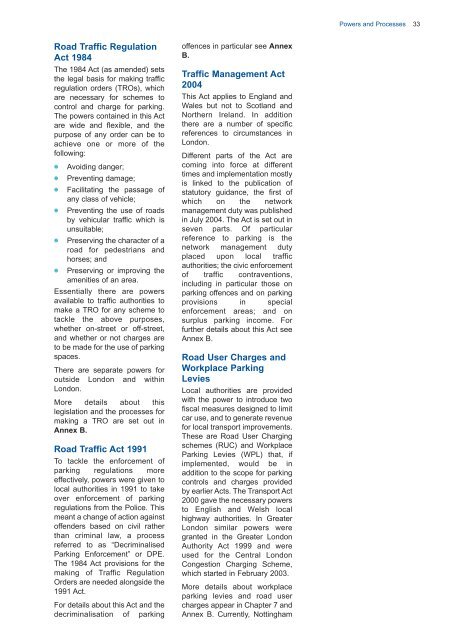titlepage/contents pg 1-16 - British Parking Association
titlepage/contents pg 1-16 - British Parking Association
titlepage/contents pg 1-16 - British Parking Association
You also want an ePaper? Increase the reach of your titles
YUMPU automatically turns print PDFs into web optimized ePapers that Google loves.
Powers and Processes 33Road Traffic RegulationAct 1984The 1984 Act (as amended) setsthe legal basis for making trafficregulation orders (TROs), whichare necessary for schemes tocontrol and charge for parking.The powers contained in this Actare wide and flexible, and thepurpose of any order can be toachieve one or more of thefollowing:● Avoiding danger;● Preventing damage;●●●Facilitating the passage ofany class of vehicle;Preventing the use of roadsby vehicular traffic which isunsuitable;Preserving the character of aroad for pedestrians andhorses; and● Preserving or improving theamenities of an area.Essentially there are powersavailable to traffic authorities tomake a TRO for any scheme totackle the above purposes,whether on-street or off-street,and whether or not charges areto be made for the use of parkingspaces.There are separate powers foroutside London and withinLondon.More details about thislegislation and the processes formaking a TRO are set out inAnnex B.Road Traffic Act 1991To tackle the enforcement ofparking regulations moreeffectively, powers were given tolocal authorities in 1991 to takeover enforcement of parkingregulations from the Police. Thismeant a change of action againstoffenders based on civil ratherthan criminal law, a processreferred to as “Decriminalised<strong>Parking</strong> Enforcement” or DPE.The 1984 Act provisions for themaking of Traffic RegulationOrders are needed alongside the1991 Act.For details about this Act and thedecriminalisation of parkingoffences in particular see AnnexB.Traffic Management Act2004This Act applies to England andWales but not to Scotland andNorthern Ireland. In additionthere are a number of specificreferences to circumstances inLondon.Different parts of the Act arecoming into force at differenttimes and implementation mostlyis linked to the publication ofstatutory guidance, the first ofwhich on the networkmanagement duty was publishedin July 2004. The Act is set out inseven parts. Of particularreference to parking is thenetwork management dutyplaced upon local trafficauthorities; the civic enforcementof traffic contraventions,including in particular those onparking offences and on parkingprovisions in specialenforcement areas; and onsurplus parking income. Forfurther details about this Act seeAnnex B.Road User Charges andWorkplace <strong>Parking</strong>LeviesLocal authorities are providedwith the power to introduce twofiscal measures designed to limitcar use, and to generate revenuefor local transport improvements.These are Road User Chargingschemes (RUC) and Workplace<strong>Parking</strong> Levies (WPL) that, ifimplemented, would be inaddition to the scope for parkingcontrols and charges providedby earlier Acts. The Transport Act2000 gave the necessary powersto English and Welsh localhighway authorities. In GreaterLondon similar powers weregranted in the Greater LondonAuthority Act 1999 and wereused for the Central LondonCongestion Charging Scheme,which started in February 2003.More details about workplaceparking levies and road usercharges appear in Chapter 7 andAnnex B. Currently, Nottingham







